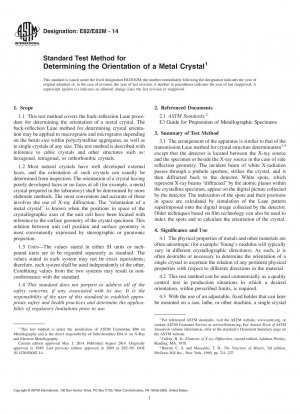ASTM E82/E82M-14
Standard Test Method for Determining the Orientation of a Metal Crystal
- Standard No.
- ASTM E82/E82M-14
- Release Date
- 2014
- Published By
- American Society for Testing and Materials (ASTM)
- Status
- Replace By
- ASTM E82/E82M-14(2019)
- Latest
- ASTM E82/E82M-14(2019)
- Scope
4.1 The physical properties of metals and other materials are often anisotropic (for example: Young''s modulus will typically vary in different crystallographic directions). As such, it is often desirable or necessary to determine the orientation of a single crystal to ascertain the relation of any pertinent physical properties with respect to different directions in the material.
4.2 This test method can be used commercially as a quality control test in production situations in which a desired orientation, within prescribed limits, is required.
4.3 With the use of an adjustable, fixed holder that can later be mounted on a saw, lathe, or other machine, a single crystal material can be moved to a preferred orientation and subsequently sectioned, ground, or processed otherwise.
4.4 If the grains in a polycrystalline material are large enough, this test method can also be used to determine their orientations and differences in orientation can be documented or mapped or both.
1.1 This test method covers the back-reflection Laue procedure for determining the orientation of a metal crystal. The back-reflection Laue method for determining crystal orientation may be applied to macrograins and micrograins depending on the beam size within polycrystalline aggregates, as well as to single crystals of any size. This test method is described with reference to cubic crystals and other structures such as: hexagonal, tetragonal, or orthorhombic crystals.
1.2 Most natural crystals have well developed external faces, and the orientation of such crystals can usually be determined from inspection. The orientation of a crystal having poorly developed faces or no faces at all (for example, a metal crystal prepared in the laboratory) shall be determined by more elaborate methods. The most convenient and accurate of these involves the use of X-ray diffraction. The “orientation of a metal crystal” is known when the positions in space of the crystallographic axes of the unit cell have been located with reference to the surface geometry of the crystal specimen. This relation between unit cell position and surface geometry is most conveniently expressed by stereographic or gnomonic projection.
1.3 Units—The values stated in either SI units or inch-pound units are to be regarded separately as standard. The values stated in each system may not be exact equivalents; therefore, each system shall be used independently of the other. Combining values from the two systems may result in non-conformance with the standard.
1.4 This standard does not purport to address all of the safety concerns, if any, associated with its use. It is the responsibility of the user of this standard to establish appropriate safety and health practices and determine the applicability of regulatory limitations prior to use.
ASTM E82/E82M-14 Referenced Document
- ASTM E3 Standard Practice for Preparation of Metallographic Specimens
ASTM E82/E82M-14 history
- 2019 ASTM E82/E82M-14(2019) Standard Test Method for Determining the Orientation of a Metal Crystal
- 2014 ASTM E82/E82M-14 Standard Test Method for Determining the Orientation of a Metal Crystal
- 2009 ASTM E82-09 Standard Test Method for Determining the Orientation of a Metal Crystal
- 1991 ASTM E82-91(2007) Standard Test Method for Determining the Orientation of a Metal Crystal
- 1991 ASTM E82-91(2001) Standard Test Method for Determining the Orientation of a Metal Crystal
- 2001 ASTM E82-91(1996) Standard Test Method for Determining the Orientation of a Metal Crystal
